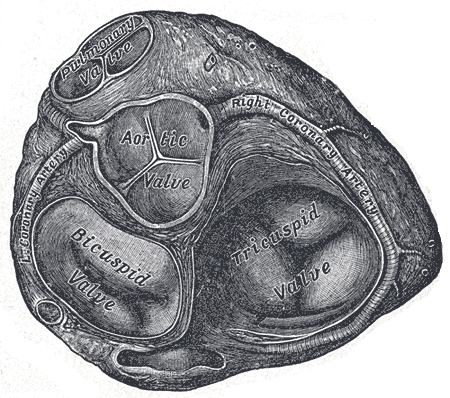[1]
Akinseye OA,Pathak A,Ibebuogu UN, Aortic Valve Regurgitation: A Comprehensive Review. Current problems in cardiology. 2018 Aug
[PubMed PMID: 29174586]
[2]
Vollenbroich R,Sakiri E,Roost E,Stortecky S,Rothenbühler M,Räber L,Englberger L,Wenaweser P,Carrel T,Windecker S,Pilgrim T, Clinical outcomes in high-risk patients with a severe aortic stenosis: a seven-year follow-up analysis. Swiss medical weekly. 2019 Feb 11;
[PubMed PMID: 30957214]
Level 2 (mid-level) evidence
[3]
Osnabrugge RL,Mylotte D,Head SJ,Van Mieghem NM,Nkomo VT,LeReun CM,Bogers AJ,Piazza N,Kappetein AP, Aortic stenosis in the elderly: disease prevalence and number of candidates for transcatheter aortic valve replacement: a meta-analysis and modeling study. Journal of the American College of Cardiology. 2013 Sep 10;
[PubMed PMID: 23727214]
Level 1 (high-level) evidence
[4]
Argulian E,Windecker S,Messerli FH, Misconceptions and Facts About Aortic Stenosis. The American journal of medicine. 2017 Apr;
[PubMed PMID: 28109966]
[6]
Yalta K,Palabiyik O,Gurdogan M,Gurlertop Y, Serum copeptin might improve risk stratification and management of aortic valve stenosis: a review of pathophysiological insights and practical implications. Therapeutic advances in cardiovascular disease. 2019 Jan-Dec;
[PubMed PMID: 30803406]
Level 3 (low-level) evidence
[7]
Turina J,Hess OM,Krayenbühl HP, [Spontaneous course of aortic valve disease and indications for aortic valve replacement]. Schweizerische medizinische Wochenschrift. 1988 Apr 9;
[PubMed PMID: 3375789]
[8]
Ito S,Pislaru C,Miranda WR,Nkomo VT,Connolly HM,Pislaru SV,Pellikka PA,Lewis BR,Carabello BA,Oh JK, Left Ventricular Contractility and Wall Stress in Patients With Aortic Stenosis With Preserved or Reduced Ejection Fraction. JACC. Cardiovascular imaging. 2019 Mar 8;
[PubMed PMID: 30878438]
[9]
Otto CM, Heartbeat: Improving diagnosis and management of aortic valve disease. Heart (British Cardiac Society). 2018 Nov;
[PubMed PMID: 30366931]
[10]
Annabi MS,Clavel MA,Pibarot P, Dobutamine Stress Echocardiography in Low-Flow, Low-Gradient Aortic Stenosis: Flow Reserve Does Not Matter Anymore. Journal of the American Heart Association. 2019 Mar 19;
[PubMed PMID: 30879376]
[11]
Kelly TA,Rothbart RM,Cooper CM,Kaiser DL,Smucker ML,Gibson RS, Comparison of outcome of asymptomatic to symptomatic patients older than 20 years of age with valvular aortic stenosis. The American journal of cardiology. 1988 Jan 1;
[PubMed PMID: 3337000]
[12]
Aalaei-Andabili SH,Bavry AA, Left Ventricular Diastolic Dysfunction and Transcatheter Aortic Valve Replacement Outcomes: A Review. Cardiology and therapy. 2019 Mar 7;
[PubMed PMID: 30847743]
[14]
Maes F,Lerakis S,Barbosa Ribeiro H,Gilard M,Cavalcante JL,Makkar R,Herrmann HC,Windecker S,Enriquez-Sarano M,Cheema AN,Nombela-Franco L,Amat-Santos I,Muñoz-García AJ,Garcia Del Blanco B,Zajarias A,Lisko JC,Hayek S,Babaliaros V,Le Ven F,Gleason TG,Chakravarty T,Szeto W,Clavel MA,de Agustin A,Serra V,Schindler JT,Dahou A,Salah-Annabi M,Pelletier-Beaumont E,Côté M,Puri R,Pibarot P,Rodés-Cabau J, Outcomes From Transcatheter Aortic Valve Replacement in Patients With Low-Flow, Low-Gradient Aortic Stenosis and Left Ventricular Ejection Fraction Less Than 30%: A Substudy From the TOPAS-TAVI Registry. JAMA cardiology. 2019 Jan 1;
[PubMed PMID: 30566185]
[15]
Pineda AM,Kiefer TL, Asymptomatic Severe Aortic Valve Stenosis-When to Intervene: a Review of the Literature, Current Trials, and Guidelines. Current cardiology reports. 2018 Oct 11;
[PubMed PMID: 30311005]
[16]
Tabata N,Sinning JM,Kaikita K,Tsujita K,Nickenig G,Werner N, Current status and future perspective of structural heart disease intervention. Journal of cardiology. 2019 Apr 4;
[PubMed PMID: 30955999]
Level 3 (low-level) evidence
[17]
Wong CHM,Chan JSK,Sanli D,Rahimli R,Harky A, Aortic valve repair or replacement in patients with aortic regurgitation: A systematic review and meta-analysis. Journal of cardiac surgery. 2019 Jun
[PubMed PMID: 30953445]
Level 1 (high-level) evidence
[18]
Siontis GC,Praz F,Pilgrim T,Mavridis D,Verma S,Salanti G,Søndergaard L,Jüni P,Windecker S, Transcatheter aortic valve implantation vs. surgical aortic valve replacement for treatment of severe aortic stenosis: a meta-analysis of randomized trials. European heart journal. 2016 Dec 14;
[PubMed PMID: 27389906]
Level 1 (high-level) evidence
[19]
Forman R,Firth BG,Barnard MS, Prognostic significance of preoperative left ventricular ejection fraction and valve lesion in patients with aortic valve replacement. The American journal of cardiology. 1980 Jun;
[PubMed PMID: 7377109]
[20]
Capoulade R,Pibarot P, Assessment of Aortic Valve Disease: Role of Imaging Modalities. Current treatment options in cardiovascular medicine. 2015 Nov;
[PubMed PMID: 26391799]
[21]
Généreux P,Pibarot P,Redfors B,Mack MJ,Makkar RR,Jaber WA,Svensson LG,Kapadia S,Tuzcu EM,Thourani VH,Babaliaros V,Herrmann HC,Szeto WY,Cohen DJ,Lindman BR,McAndrew T,Alu MC,Douglas PS,Hahn RT,Kodali SK,Smith CR,Miller DC,Webb JG,Leon MB, Staging classification of aortic stenosis based on the extent of cardiac damage. European heart journal. 2017 Dec 1;
[PubMed PMID: 29020232]
[22]
Campo J,Tsoris A,Kruse J,Karim A,Andrei AC,Liu M,Bonow RO,McCarthy P,Malaisrie SC, Prognosis of Severe Asymptomatic Aortic Stenosis With and Without Surgery. The Annals of thoracic surgery. 2019 Mar 7;
[PubMed PMID: 30905426]

